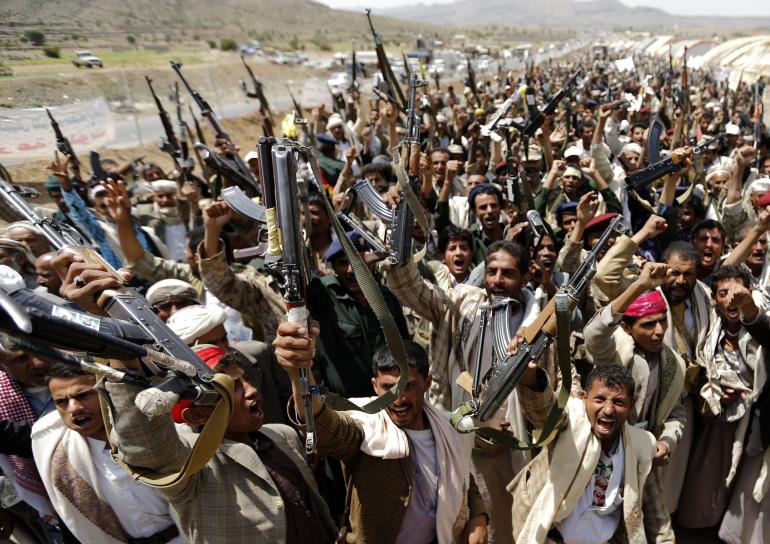Obama’s Middle East “Success”: Yemen Falls Apart… Presidential Palace Seized
 Yemeni Muslims have begun shelling the nation’s presidential palace in the capital city of Sanaa, and some reports suggest they have stormed the building.
Yemeni Muslims have begun shelling the nation’s presidential palace in the capital city of Sanaa, and some reports suggest they have stormed the building.
According to Reuters, the government’s security forces mounted only brief resistance before handing the presidential compound over to insurgent forces, having endured a day of heavy shelling from rebel artillery. Some witnesses also reported seeing the rebels seize armored fighting vehicles from government forces, which is exactly how ISIS built up its motor pool in Iraq.
At least two Yemeni Interior Ministry officials confirmed the fall of the presidential palace to CNN, which reported the apparent end of a brief cease-fire and renewed clashes in the streets of Sanaa. “Gunfire could be heard sporadically across the city Tuesday, whereas a day earlier it was constant,” the network reported. Some of that sporadic gunfire was directed at a U.S. Embassy vehicle full of diplomatic personnel, which was able to escape from the attack without injuries.
There is a secondary presidential residence in Sanaa, separate from the palace, where President Hadi is said to have taken refuge. The BBC reports that the second compound is under siege as well, taking heavy fire from nearby rooftops. Houthi forces have also attacked the Prime Minister’s convoy and kidnapped President Hadi’s chief of staff.
The commander of the presidential guards is quoted describing the situation as a “coup,” alleging that the rebels had help from the inside. The UK Telegraph suggests that help might have come from forces loyal to Hadi’s predecessor, Ali Abdullah Saleh, who was somewhat less cooperative with the Obama Administration, but on much better terms with the Houthis. Eyewitnesses claim some of the troops defending the presidential palace retired from their positions without fighting the rebels, while others report seeing a detachment of government troops departing the home of Saleh’s son Ahmed to actively join the rebels.
The insurgency has two distinct branches: al-Qaeda in the Arabian Peninsula (AQAP), who are generally Sunni Muslims, and the Shiite minority known as the Houthis. The Houthis laid siege on Sanaa last year but agreed to a cease-fire in exchange for increased political influence.
Despite the enduring conflict, President Obama presented Yemen to the American people as an example of a successful counter-terrorism battlefield as recently as last September:
I want the American people to understand how this effort will be different from the wars in Iraq and Afghanistan. It will not involve American combat troops fighting on foreign soil. This counter-terrorism campaign will be waged through a steady, relentless effort to take out ISIL wherever they exist using our air power and our support for partner forces on the ground. This strategy of taking out terrorists who threaten us, while supporting partners on the front lines, is one that we have successfully pursued in Yemen and Somalia for years.
Even as President Obama spoke those words, those familiar with the actual situation in Yemen and Somalia were scratching their heads and wondering if he’d lost his mind. Yemen, in particular, was no rational person’s idea of a strategic success. An incredulous Shuaib Almosawa at the Daily Beast speculated Obama was giddy over a relatively smooth transition of presidential power in Yemen, perhaps thinking low-information American voters would compare it favorably to “the disaster in Syria and the complications of Egypt.”
There had been some past successes in taking out terrorist targets, moments when it could be said American counter-terrorism forces were playing bad cards as skillfully as possible in Yemen, but by the time Obama spoke in September, Almosawa’s review of Yemeni intelligence documents led him to conclude that “Obama’s Yemen model has been helpless to prevent recent waves of al-Qaeda attacks despite being notified of their specifics days and weeks before.”
This is all unlikely to be mentioned prominently in President Obama’s State of the Union infomercial, but rest assured al-Qaeda is watching closely and liking what it sees. Fresh off taking credit for financing the Charlie Hebdo massacre, the gang President Obama once claimed he had “decimated” has realistic ambitions of building a stronghold in Yemen.
There is bad blood between the Sunni terror gang and the Shiite Houthi rebels, but al-Qaeda can pick off the battered victor of the coup, exploiting a time of chaos that leaves few guns pointed in their direction. As the September article in the Daily Beast explained, the Houthis come from Yemen’s north, while al-Qaeda has been preying on cities in the south, a strategy that has long relied upon discord in Sanaa and tension with the Houthis (and other disgruntled, marginalized tribes) to provide cover.
There’s not much room for America to deal itself into that bloody game, since the Houthis have only a slightly higher opinion of the United States than al-Qaeda does, while appearing quite fond of the Shiite regime in Iran. The feeling is mutual; a Reuters report goes so far as to credit Iranian support for helping the Houthis destabilize Yemen. One of the big Houthi complaints about Hadi’s government is that he is an American puppet who uses his American-trained military to crack down on dissent. (They’re not wrong about that – the Hadi government has violently shut down opposition media and deported foreign reporters whose coverage displeases it.)
If the regime falls, the Obama Administration’s heavy investment in Hadi over Saleh will come to nothing, and Yemen will be ruled by either anti-American nationalists, al-Qaeda, or both. That’s not a “model” for anything except horror and chaos, and as the Charlie Hebdo attack demonstrates, the chaos will not remain bottled up inside Yemen’s borders.
